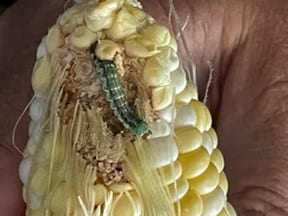–by Jeff Whitworth –Field Crops Entomologist
Most corn has recently tasseled, just is, or will be soon. 100% of all the ears we examined in the last 2 weeks, both sweet and field corn, were infested with at least one “earworm”. This is not unusual. All “earworms” were only one half to three fourths grown (see fig 1)

Figure 1: Corn ear worm
as of 18 July. Thus, these worms should cease feeding in the next 7-14 days, pupate in the soil for 4-7 days, and then emerge as adult moths. These moths will then mate and fly to a suitable host plant to start depositing eggs. Whether sorghum or soybeans depends upon the crop’s stage of growth when these moths are actively depositing eggs. Double cropped soybeans may be attractive to moths for another 1-3 months as the plants continue to set pods, and thus there could be another 1- 3 generations of larvae feeding on the bean within the pod. Sorghum, however, should only attract moths from flowering to soft dough–a much smaller oviposition window, but very critical because generally one larva causes 5% loss in grain.